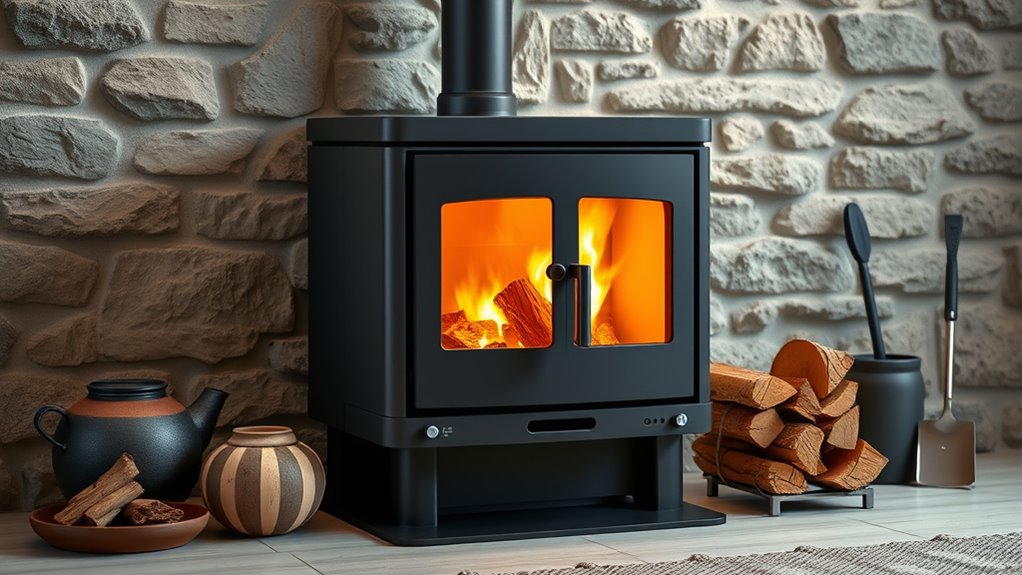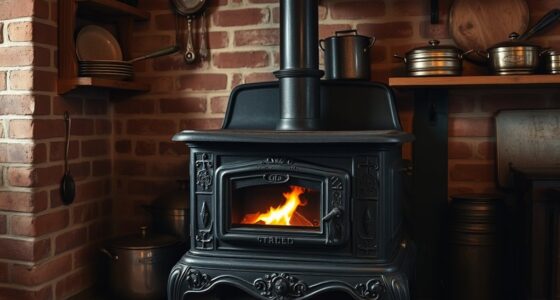In the 21st century, wood stoves have become more efficient, cleaner, and smarter with innovations like advanced combustion tech, emission controls, and app-controlled features. Stricter standards, certifications, and eco-friendly designs push manufacturers toward sustainable solutions that reduce pollutants by up to 90%. Modern stoves also connect to your lifestyle with automation and digital interfaces, all while maintaining the nostalgic and cultural appeal of fire. If you continue exploring, you’ll discover even more exciting developments shaping this timeless technology.
Key Takeaways
- Advanced combustion technologies and airflow systems significantly reduce emissions, with some designs achieving up to 90% particulate reduction.
- Stricter standards like EPA 2015 and Ecodesign 2022 drive innovation toward cleaner, more efficient, and certified wood stove models.
- Smart features such as app controls, sensors, and automation enhance user convenience, safety, and combustion efficiency.
- Certification programs and eco-labels verify compliance, with ongoing efforts to ensure real-world emission reductions.
- Cultural significance persists, with modern designs blending tradition and technology to meet aesthetic, functional, and environmental demands.
Evolution of Wood Stove Design and Efficiency
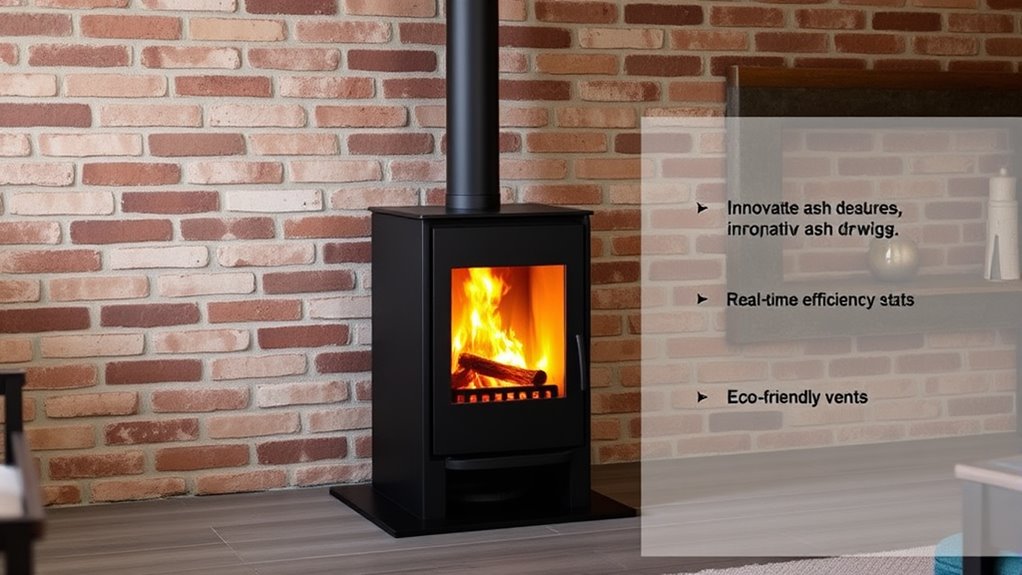
Have you wondered how modern wood stoves have become so much more efficient and cleaner over the years? It all comes down to advances in combustion technologies, like secondary and tertiary air systems, which maximize fuel use and improve efficiency. Ecodesign standards introduced in 2022 push manufacturers to develop cleaner-burning models that meet strict emission limits, making stoves more environmentally friendly. Innovative designs, such as app-controlled smart stoves, enable remote monitoring and automatic adjustments, optimizing combustion and reducing emissions. Additionally, high-efficiency stoves now incorporate thermal storage and advanced airflow systems to boost heat retention and cut wood consumption. The integration of catalytic technology and airtight chambers further minimizes particulate emissions, reflecting a significant evolution in stove design focused on performance, sustainability, and cleaner operation. Understanding emission standards has also played a crucial role in driving these innovations. Improved combustion efficiency techniques continue to enhance both environmental performance and user comfort, supported by ongoing research in airflow management. Furthermore, advancements in AI-driven safety monitoring are beginning to influence modern stove controls, enhancing reliability and user safety. Additionally, ongoing research into reduction of particulate matter aims to further improve air quality and health impacts associated with wood stove use.
Cutting-Edge Technologies Reducing Emissions
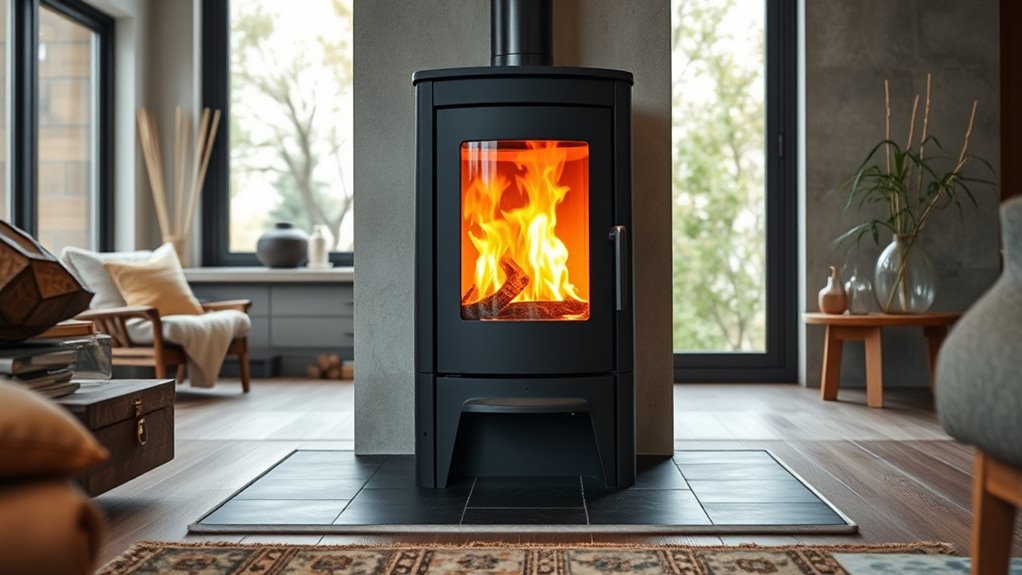
Cutting-edge technologies are revolutionizing how wood stoves reduce emissions, making them cleaner and more efficient than ever. Advanced combustion systems, like secondary and tertiary air injection, can cut particulate emissions by up to 90%, considerably lowering PM2.5 levels. Sensor technologies enable real-time monitoring of emissions during operation, helping verify reductions accurately. Electrostatic precipitators (ESPs) integrated into modern stoves capture over 95% of particulate matter before it escapes into the air. Certification programs, such as Ecodesign, ensure stoves meet strict emission limits—under 2.0 grams per hour—through optimized airflow and combustion chamber design. Innovations like combustion efficiency are also improving how thoroughly fuel is burned, further reducing emissions. Additionally, ongoing research into emission control techniques is driving continuous improvements in reducing pollutants. These innovations collectively push wood stoves toward cleaner operation, helping you reduce your environmental footprint while maintaining efficient heating. Advances in material science have also contributed to the development of more durable and heat-resistant components that support these emission reduction technologies. Moreover, the integration of digital controls allows for precise regulation of combustion parameters, enhancing overall efficiency and emission performance. Creativity in designing these technologies has driven innovative solutions that improve both efficiency and environmental impact.
Smart Features and Automation in Modern Stoves
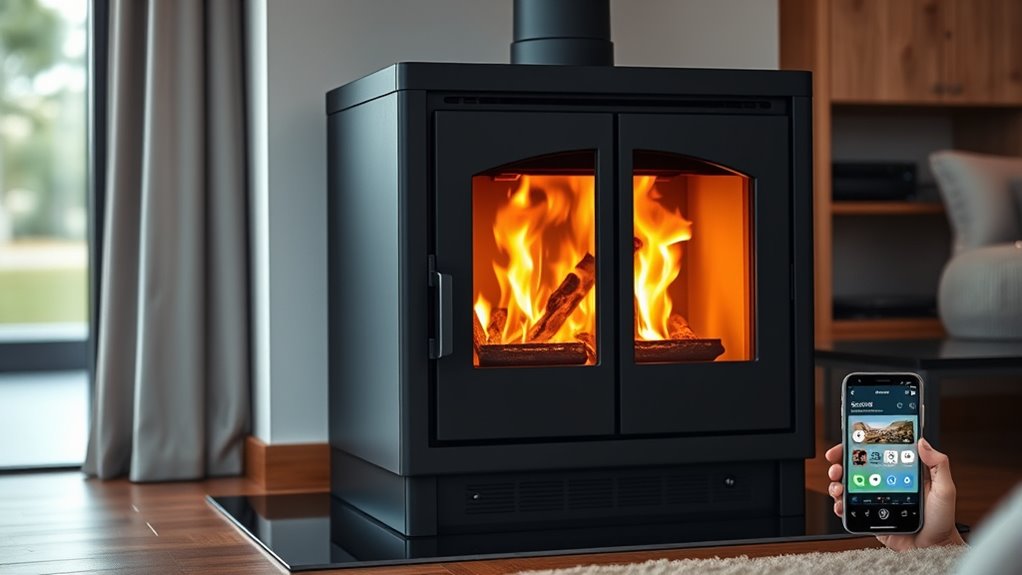
Modern wood stoves are increasingly equipped with smart features and automation that enhance both convenience and environmental performance. With app-controlled systems, you can monitor and adjust fire settings remotely, ensuring ideal efficiency and safety. Combustion intelligence technology automatically regulates airflow based on real-time data, reducing emissions while maximizing heat output. Advanced digital interfaces provide instant feedback on burn performance, fuel consumption, and air quality, helping you optimize operation and minimize pollution. Sensors such as opacity emissions meters and particulate monitors continuously track smoke emissions, supporting regulatory compliance and protecting air quality. Additionally, real-time data analysis helps users make informed decisions about their stove usage and maintenance. The integration of automation technologies is also making these devices more adaptable to different heating needs and environments. These innovative features are part of the growing trend toward smart appliances, which integrate technology into traditional heating solutions. Features like automatic ignition, temperature control, and programmable burn cycles make your stove easier to operate and cleaner to use, ultimately promoting a more sustainable and user-friendly heating experience. The incorporation of smart technology not only improves efficiency but also aligns with the broader movement toward environmentally responsible and connected home devices. Moreover, energy efficiency standards are encouraging manufacturers to innovate further, resulting in even smarter and more eco-friendly options for consumers.
Standards, Certifications, and Regulatory Progress

You should be aware of how emissions standards are evolving to reduce pollution from wood stoves, like Europe’s Ecodesign rules and the U.S. EPA’s updated limits. Certifications such as the Nordic Swan and CE mark help verify compliance and environmental performance, but challenges remain with real-world emissions and certification flaws. Ongoing regulatory progress aims to push manufacturers towards cleaner, more efficient wood stove designs, though debates about stricter standards continue. Additionally, cybersecurity vulnerabilities, such as Hack’n Jill, highlight the importance of robust digital security measures in safeguarding environmental and consumer data.
Emissions Standards Evolution
Over the past decade, emissions standards for residential wood stoves have become markedly stricter, driven by advances in technology and increased environmental awareness. The EPA set new standards in 2015, limiting particulate emissions to 2.5 grams per hour for new models, pushing manufacturers to reduce smoke output. The European Union’s Ecodesign regulations, introduced in 2022, impose strict limits on PM, NOx, and CO emissions, while demanding higher efficiency levels. The certification process now involves rigorous testing both in labs and real-world conditions, ensuring accurate emission reporting. Many appliances achieve Ecodesign Level 4 or 5, reducing emissions by up to 90% compared to older, non-compliant stoves. These evolving standards promote cleaner, more efficient wood stoves aligned with environmental goals. Additionally, advancements in pollution reduction technology have enabled manufacturers to develop models that meet these increasingly stringent regulations while maintaining performance and usability. The integration of advanced materials has further enhanced the durability and effectiveness of emission control components, supporting compliance with the latest standards. Moreover, ongoing research into emission control technologies continues to drive innovations that benefit both the environment and consumers, often utilizing water-based systems to capture pollutants more effectively.
Certification and Compliance
Certification and compliance play a crucial role in ensuring that wood stoves meet the increasingly strict environmental standards set by regulators. Certifications like the Nordic Swan EcoLabel and the European CE mark verify that stoves meet rigorous emission standards and efficiency requirements. The industry’s advanced certifications, such as the clearSkies label, go beyond the Ecodesign regulations by certifying appliances with markedly lower emissions. The recent European Ecodesign regulations, introduced in 2022, impose strict limits on PM, NOx, and CO emissions, while the U.S. EPA’s 2020 standards cap particulate matter at 2.5 grams per hour. Despite these efforts, challenges persist due to flaws in certification processes and the gap between lab-tested and real-world emissions, underscoring the ongoing need for strict compliance and verification.
The Rise of Ecodesign and Sustainable Heating Solutions
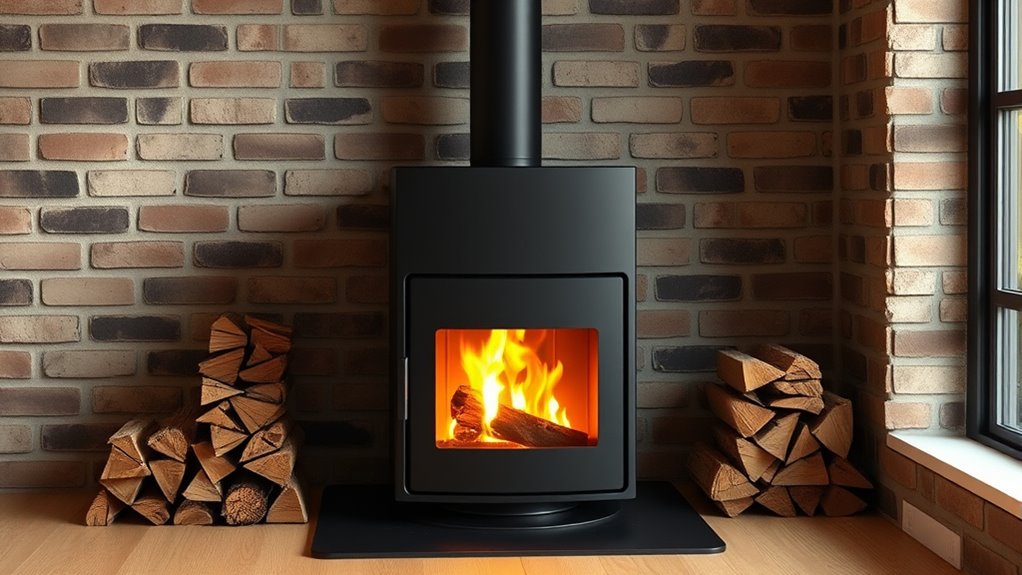
How has the industry responded to the urgent need for cleaner, more sustainable heating options? By embracing Ecodesign regulations introduced in 2022, manufacturers have pushed for cleaner burning wood stoves that meet strict emission limits. Certified Ecodesign models now achieve at least 75% efficiency and emit 88% less CO than older versions, reducing emissions markedly. Advanced combustion technologies, like secondary and tertiary air systems, enable near-complete burning of gases and particulates, making stoves more efficient and eco-friendly. The certification process emphasizes environmental impact, encouraging innovations like the clearSkies program and Level 4 & 5 appliances, which can cut emissions by up to 90%. This shift highlights a strong industry move toward sustainable heating solutions that prioritize lower emissions and cleaner burning. Additionally, proper operation techniques are essential for maximizing these benefits and minimizing side effects of improper operation, ensuring safer and cleaner use of modern wood stoves. Implementing industry standards further supports consistent quality and environmental compliance across manufacturers. Promoting consumer awareness about these best practices further supports the industry’s sustainability goals. Moreover, ongoing research and development continue to refine combustion technology, making future models even more environmentally friendly.
The Cultural and Emotional Significance of Fire Today
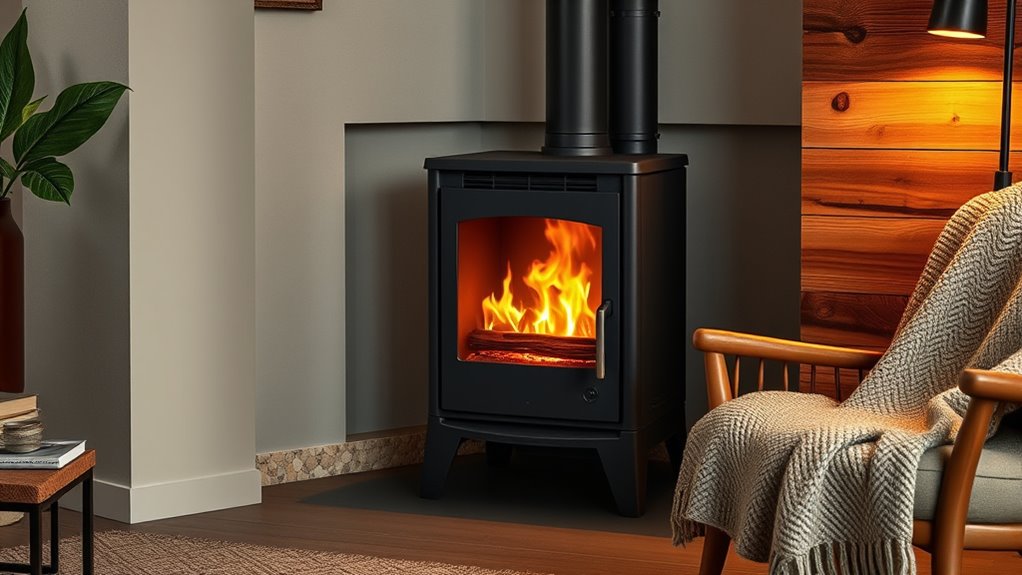
Fire still symbolizes warmth, security, and tradition in your life, creating emotional bonds and a sense of community. Modern stoves and fireplaces evoke nostalgia and connect you to rituals that give a feeling of achievement and independence. These flames continue to shape your memories, gatherings, and your primal connection to nature. Additionally, the craftsmanship behind precious metals investments reflects a desire for enduring value and stability in uncertain times.
Fire as Cultural Symbol
Have you ever noticed how the flickering flames of a modern stove or fireplace evoke feelings of comfort and nostalgia? Fire has long been a symbol of safety, warmth, and community, shaping traditions and cultural identities worldwide. Today, the glow of fire still connects us to our primal roots, reminding us of shared experiences during holidays, outdoor gatherings, or personal achievements. Despite technological advances, fire remains a powerful emblem of independence and strength. It reinforces social bonds through rituals like campfires and ceremonial lighting, creating lasting memories. In our increasingly digital world, fire’s cultural significance endures, offering authenticity and tranquility. You feel this connection whenever you gather around a fire, embracing the timeless role fire plays in shaping community and cultural identity.
Rituals and Traditions
Even in an era dominated by technology, many people find deep emotional and cultural meaning in the rituals of building and tending a fire. Fireplaces and wood stoves serve as central hubs for rituals and traditions that foster connection and pride. Chopping logs, stacking wood, and maintaining a fire become meaningful acts that link you to primal roots and shared customs. These rituals often mark special occasions like holiday gatherings or quiet evenings, reinforcing cultural identity through storytelling and togetherness. Despite modern conveniences, the tactile experience of wood burning and the flickering flames evoke nostalgia and comfort. The calming ambiance created by fire’s glow sustains a sense of warmth, community, and tradition that remains essential in contemporary life.
Modern Lifestyle Connection
Why does the glow of a wood stove still hold such powerful appeal in today’s fast-paced world? Because fireplaces foster a deep emotional connection, blending tradition with modern design. They evoke authenticity, reminding us of primal roots while fitting seamlessly into contemporary homes. Fireplaces create cozy atmospheres that invite relaxation and social bonding during cold seasons. Building and maintaining a fire offers a ritual that sparks pride and independence, reinforcing a sense of accomplishment.
| Traditional Charm | Modern Elegance |
|---|---|
| Authenticity | Contemporary design |
| Emotional warmth | Cozy atmospheres |
| Ritual significance | Social bonding |
| Cultural roots | Primal connection |
Market Diversity and Consumer Preferences in 2022
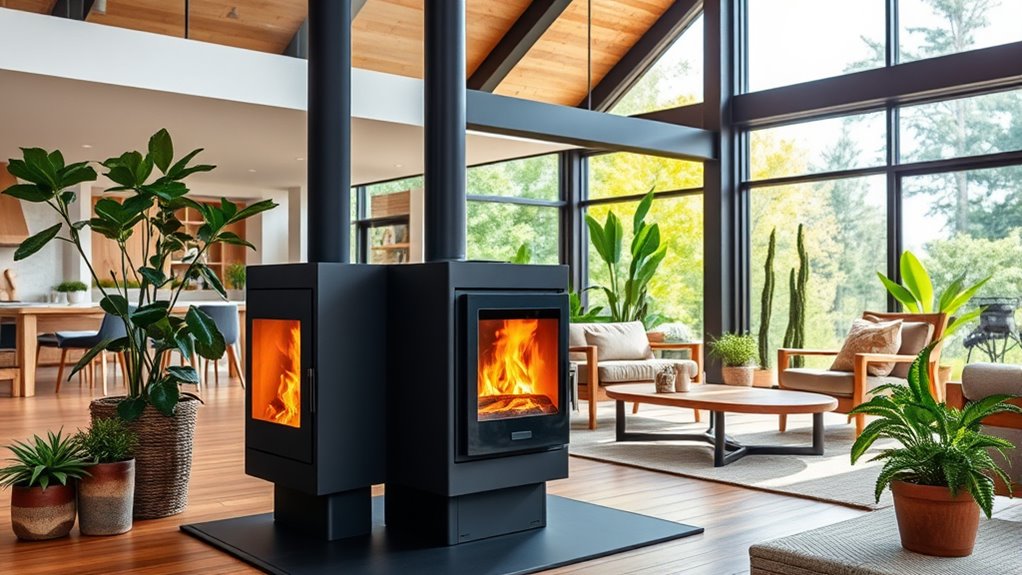
In 2022, the wood stove market showcased remarkable diversity, offering a broad spectrum of designs to meet varied consumer tastes and functional needs. You could choose from traditional cast iron models or sleek, contemporary styles that suit modern interiors. Ecodesign-certified stoves, featuring advanced emission-reducing technology, appeal to environmentally conscious buyers seeking cleaner heating options. App-controlled smart stoves from brands like Hwam and Contura gained popularity for their remote operation and real-time efficiency monitoring, aligning with digital trends. High-efficiency models, surpassing 80%, delivered cost savings and sustainable heating. This variety allows you to select a stove that matches your aesthetic preferences, functional requirements, and environmental values, reflecting a market that truly caters to diverse consumer preferences and prioritizes efficiency.
Frequently Asked Questions
What Is the Future for Wood-Burning Stoves?
You’re wondering about the future of wood-burning stoves. As technology advances, you’ll see cleaner, more efficient models with smart controls and sensors that optimize performance and cut emissions. Stricter regulations push manufacturers toward ultra-low emission designs, while renewable options like heat pumps grow in popularity. Overall, you’ll find that innovative, eco-friendly materials and high-tech features keep wood stoves relevant, sustainable, and a viable heating choice for years to come.
Are Wood Stoves Making a Comeback?
Yes, wood stoves are making a comeback. You’ll notice newer models with advanced emissions controls and smarter features, like app controls, that appeal to eco-conscious homeowners. Industry innovations address pollution concerns, boosting confidence in their use. With a focus on energy independence and renewable fuels, you can now choose high-efficiency, stylish stoves that meet strict regulations, making them a sustainable and attractive heating option for your home.
Are Newer Wood Stoves More Efficient?
Imagine upgrading your old stove and noticing how much less wood you need to keep your home warm. The answer is yes—you’ll find newer wood stoves far more efficient, often exceeding 80% efficiency. Thanks to innovations like secondary combustion and airtight seals, they burn cleaner and use less fuel. This means you get more heat, less waste, and a smaller environmental footprint, making modern stoves a smart choice.
How Does the 26% Tax Credit for a Wood Stove Work?
You can take advantage of the 26% tax credit by purchasing and installing a qualifying wood stove in 2023. To benefit, you need to itemize your taxes, keep receipts, and confirm the stove meets energy efficiency standards or EPA certification. The credit reduces your tax bill by 26% of the purchase and installation costs, but there’s a cap. This incentive helps make cleaner, efficient stoves more affordable for you.
Conclusion
Imagine warming your home with a stove that’s both efficient and eco-friendly, like a well-tuned orchestra. Today’s innovations, from smart features to stricter standards, guarantee you get cozy without guilt. Just as a fire’s glow can bring comfort and connection, these advancements make sustainable heating accessible and reliable. Embrace the future of wood stoves—where tradition meets technology, igniting a greener, smarter way to heat your space.

